Papers by maria grazia gnoni
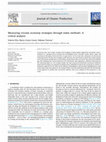
In the last years, the circular economy (CE) paradigm is being widely explored by researchers and... more In the last years, the circular economy (CE) paradigm is being widely explored by researchers and institutions as a possible path to increase the sustainability of our economic system. Reuse, repair and recycling are becoming crucial activities in many sectors. At the same time, companies are showing an increasing interest for this new economic model. However, the state of the art shows that a deep research on CE assessment and indicators is still lacking, in particular on the micro level. This work tries to fill this gap, first analyzing the current literature on CE assessment, then proposing a reference framework for the monitoring phase of a CE strategy. Finally, the main existing environmental assessment methodol-ogies based on indexes are analyzed according to their suitability to evaluate the circularity of a system. A systematic approach for the choice of the adequate methodology is also provided, highlighting the main critical steps in the assessment of a CE strategy. Further research could be focused either on the extension of this approach to include other assessment methods, and on the validation of this proposal in a case study.
Business Performance Measurement and Management, 2009
Cold chain management represents a focal activity in several industrial contexts from food to che... more Cold chain management represents a focal activity in several industrial contexts from food to chemical chains (i.e. fresh food, vaccines or pharmaceutical products). It involves a network of temperature controlled processes and vehicles, which have to be strictly interconnected and monitored to assure product protection for both sanitary and economical reasons. All these factors could be managed by a more efficient system for improving visibility and traceability, based on Radio Frequency Identification (RFID) applications. The paper aims to highlight a metric model for assessing effectively economic performances of an RFID application in a specific cold chain. The model could support the design and the control of the whole cold supply chain by evaluating technological and managerial implication of the RFID application.
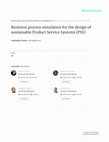
Nowadays, a lot of manufacturing companies are shifting their value proposition from a product-ce... more Nowadays, a lot of manufacturing companies are shifting their value proposition from a product-centric perspective to sustainable Product-Service-Systems (PSS). This transition allows companies to improve the customization of their offer and to contribute to the reduction of material flow and consumption; nonetheless, it poses some new challenges in terms of mindset and organization. In particular, the analysis of the literature about PSS shows that there is still a gap concerning the evaluation and the monitoring of new or reengineered PSS provision processes using business process simulation. Few examples of simulation in PSS field can be found, and multidimensional models considering customer perspective and environmental sustainability beyond the economic driver are not yet available. Thus, the purpose of this paper is to compare different simulation paradigms and to define the most suitable to support the engineering phase of a sustainable, customer-oriented PSS. Two possible alternatives were identified and discussed through a test-case.

New business models are emerging in the FMCG retail sector due to the wide diffusion of digital t... more New business models are emerging in the FMCG retail sector due to the wide diffusion of digital technologies; innovative tools -such as Pervasive Retailing Information Systems -are wide spreading all over the world aiming to increase customer loyalty and retailer performance. Furthermore, the recent mass diffusion of mobile technologies is also contributing to modify customer satisfaction towards the shopping process. In this context, new generations of self-service systems -i.e. mobile Self-Checkout Systems (mSCSs)-are becoming widely adopted by FMCG (Fast Moving Consumer Goods) retail companies: the aim is to both speed up the customer-shopping trip and increase customer satisfaction. A mSCS is a selfcheckout system based on mobile technology. Traditionally, self-checkout systems have been applied to speed up the customer purchase process; impacts on retailer performance could also be evaluated in order to optimize labor force at store level. The paper proposes a comparison analysis about the application of different types of mSCSs at FMCG retail stores: the study will focus on analyzing quantitatively impacts on time based metrics both from the customer and the retailer points of view. The study will be helpful for practitioners in designing their own mSCS; furthermore, a structured model for evaluating potential impacts of innovative technologies at the retail sector as a result. Finally, a discrete-event simulation model has been developed to quantitatively compare different mSCSs in a case study.
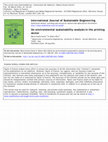
International Journal of Sustainable Engineering, 2013
Information and communication technology tools could currently contribute to support firms in inc... more Information and communication technology tools could currently contribute to support firms in increasing the environmental sustainability of their production processes: the capability to monitor data on environmental performance is a key feature. This study proposes a decision support system for estimating and assessing the environmental performance of a specific printing product. Environmental sustainability concepts are just being applied in the printing sector: a critical analysis has highlighted that environmental eco-labelling schemes are widespread for raw materials; a few of interest have been addressed by researchers and practitioners to final products. The approach proposed aims to collect and merge environmental features of raw materials with data about printing processes carried out directly by the firm. Thus, the model allows a fast but integrated assessment of the whole environmental sustainability level of a specific printing product. With this, an overall sustainability assessment could be supplied to the final customer and to firm managers by integrating economic and environmental information in a common decision system. A prototypal software tool has been developed based on the approach proposed: the tool could be applied in the design as well as in the control phase for supporting scenario analyses to improve the environmental sustainability level of such a product.

In recent years, increasing attention from both industries and research has been focused on carbo... more In recent years, increasing attention from both industries and research has been focused on carbon
capture and, subsequently, storage technologies. These technologies will contribute to companies’
strategies for reducing greenhouse gas emissions from fossils fuels. However, less effort has been spent
on evaluating another interesting option after carbon capture: carbon utilisation or reuse. A feasibility
study regarding an Italian industrial district is discussed: the district is characterised by the nearby
locations of a CO2 producer (i.e. an natural gas combined cycle power plant) and a CO2 user (i.e. a sugar
factory). The annual average CO2 emission by the power plant is about 1.7 million tonnes. Under current
conditions the sugar factory ‘produces’ CO2 to use it in the sugar refining process; thus, the idea is to
evaluate the feasibility of capturing CO2 emitted from the power plant and reusing it in the sugar factory
process from both a technological and an economic point of view. The results indicated a cost saving of
about 42% in the operational costs of the sugar factory due to the introduction of the carbon reuse
technology.
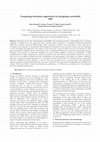
Starting from the ‘90s and 2000s, environmental sustainability and servitization played a predomi... more Starting from the ‘90s and 2000s, environmental sustainability and servitization played a predominant role in spurring companies to change their value proposition from a product-centric perspective to sustainable Product-Service-System (PSS). The evolution towards the PSS paradigm allows companies to improve the customization of their offer and to contribute to the reduction of material flow and consumption; nonetheless, on the other side it poses some new challenges in terms of mindset and organization. The analysis on the current state of art in PSS, however, shows that there is still a gap concerning the evaluation and the monitoring of new or reengineered PSS provision processes using business process simulation. Even though few simulation paradigms have been recently applied to explore the potentialities of PSS, multidimensional models considering the customer perspective and environmental sustainability beyond the economic driver are not yet available. Starting from these considerations, the main purpose of this paper is to define a simulation approach to support the engineering phase of a sustainable, customer-oriented PSS. Two possible alternative approaches have been identified and then adopted in a test-case from the automotive sector to measure three main performance indicator categories: beyond process efficiency, customers satisfaction and environmental sustainability are included in the analysis. Finally their ability to monitor and balance the performance of a PSS process according to the three categories have been compared and discussed.
Accidents and near-miss events are usually characterized by common causes and different consequen... more Accidents and near-miss events are usually characterized by common causes and different consequences; a near-miss event is a potential hazardous condition where the accident sequence was interrupted; these events have common causes with accidents (or injuries), but, differently from the latters near miss consequences are null (or reduced).
Recent serious accidents happened in railway tunnels in the last few years have forced innovation... more Recent serious accidents happened in railway tunnels in the last few years have forced innovations in legislations applied several countries; thus, new methods are developing in order to evaluate safety levels of existing tunnels and to establish new safety measures. Current research effort is focused on developing a methodology which could be effectively applied to human-machine systems. The aim of our work is the development of a methodological approach for risk analysis in railway tunnels in order to ensure the safety of users, staff and the emergency services. The authors propose a RFID system performance model for the monitoring of critical parameters and the prevention of accidents.

At the warehouses of hazardous chemicals many occupational risks are present, including chemical ... more At the warehouses of hazardous chemicals many occupational risks are present, including chemical exposures, fires, toxic clouds and explosions. The warehouses are clearly distinguishable from the other of chemical industry for plant simplicity, chemical diversity, small staff, and product packaging. Due to the current dynamism of the market, these firms are now facing emerging risks as workplace conditions-which mainly depend on stored quantities in each period-could heavily vary. Customers in the chemical supply chain are now adopting the "just-in-time" policy, which reduce their own inventory and risk levels. Thus, risks are transferred to the supply chain, including chemical warehouses. The first goal of the paper is to define a reference model for assessing and managing dynamically different risk types, typical of chemical warehouses. The safety managers have to be enabled to assess dynamically all hazard associated with stored chemicals and related activities and quickly redirect the control measures. A further aim is to understand the potential for safety of Radio Frequency Identification (RFID) technologies, already popular in logistic activities. The paper will focus on technical and economic feasibility of a Real Time Location Systems (RTLS) based on RFID technology for tracking workers and assets in chemical warehouses. A real case study analysis is discussed.
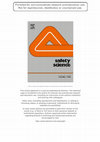
A critical component of a safety management system is the Near-miss Management System (NMS). An
... more A critical component of a safety management system is the Near-miss Management System (NMS). An
effective NMS aims to recognize signals from the operational field in order to apply more effective prevention
strategies. These systems are widespread in industrial contexts characterized by a high risk level,
such as major hazard and hospital sectors. Few examples occur in manufacturing processes which are
characterized by different operational conditions at workplace and, consequently, different risk types. The Lean Thinking (or Management) strategy currently represents a worldwide competitive tool for improving productivity in the manufacturing sector all over the world. Thus, the application of these principles forces firms to define new approaches to design and manage the whole organization and consequently the safety management system. The paper proposes innovative design of a NMS based on the integration of principles of Lean Management in occupational safety for a worldwide automotive supplier firm. As no reference model has been previously defined, several factors have been assessed aiming to efficiently integrate occupational safety in the current Lean Management system. Innovative features characterizing the proposed model have been also discussed together with first results obtained by the
full scale application.
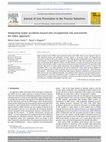
Major Accident Hazard (MAH) and Occupational Safety and Health (OSH) are two separated topics in
... more Major Accident Hazard (MAH) and Occupational Safety and Health (OSH) are two separated topics in
both industrial practice and legislation; recently, interest is increasing toward an integrated risk
assessment mainly forced by the tendency to a more efficient safety management system. The present study proposes a semi-quantitative approach to integrate MAH in OSH risk assessment. The two risk types are characterized by opposite features: the OSH analysis is usually task-based and focused on job profiles, while the MAH analysis is space-based and focused on plant characteristics. The basic idea of the proposed approach is to merge spatial information and job profile features in order to improve OSH assessment; thus, a risk index derived by the recent standard ISO 12100 (2010) has been adapted. In detail, the proposed index combines exposure times of each worker at each plant unit e derived from the OSH analysis e with damage areas derived from MAH analysis allowing a quantitative assessment of the MAH risk level for each individual job profile. The model has been tested in a large petrochemical plant; several hypotheses have been developed in order to validate the model. Results have showed the potentiality of the proposed approach in providing a common and coherent representation of both MAH and OSH risks, according to job profiles and plant units.

Information and communication technology tools could currently contribute to support firms in inc... more Information and communication technology tools could currently contribute to support firms in increasing the environmental sustainability of their production processes: the capability to monitor data on environmental performance is a key feature. This study proposes a decision support system for estimating and assessing the environmental performance of a specific printing product. Environmental sustainability concepts are just being applied in the printing sector: a critical
analysis has highlighted that environmental eco-labelling schemes are widespread for raw materials; a few of interest have
been addressed by researchers and practitioners to final products. The approach proposed aims to collect and merge
environmental features of raw materials with data about printing processes carried out directly by the firm. Thus, the model allows a fast but integrated assessment of the whole environmental sustainability level of a specific printing product. With this, an overall sustainability assessment could be supplied to the final customer and to firm managers by integrating
economic and environmental information in a common decision system. A prototypal software tool has been developed based on the approach proposed: the tool could be applied in the design as well as in the control phase for supporting scenario analyses to improve the environmental sustainability level of such a product.
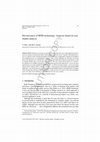
RFID technology is no longer an experimental technology but is now widely applied in business
pr... more RFID technology is no longer an experimental technology but is now widely applied in business
processes aiming to increase performance both in public and private sectors. Together with traditional sectors
(e.g. logistics, retail), the large potentiality of this technology is supporting its adoption in completely
new emerging sectors (e.g. entertainment, payment). Thus, several challenges are still open: one critical
point is the application cost; furthermore, as several research studies have pointed out operational as well
as strategic benefits, this is yet an open research topic. The aim of the proposed study is to “measure”
the adoption level of RFID technology by critically analyzing field study applications: a survey has been
performed on case studies published by RFID Journal – a well-known media company – in two years (from
January 2010 to January 2012). A specific taxonomy – based on main critical points characterizing RFID
application – has been proposed in order to support potential RFID adopters in designing their own application.
Results have showed as RFID technology is really pervasive in several sectors and geographical
areas, even if the level of diffusion is quite different from one area to another.
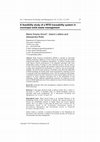
Radio frequency identification (RFID) is currently an interesting
enabling technology applied in... more Radio frequency identification (RFID) is currently an interesting
enabling technology applied in several contexts for tracing items and people
starting from logistics to healthcare management. An effective tracing system
could improve heavily performances of an integrated municipal solid waste
management systems. Focusing on waste collection services, one key point is
to trace wastes (in their quantity and typology) collected from citizens in order
to apply more transparent fee mechanisms, i.e., based on ‘pay-as-you-through’
principle. The present paper proposes a feasibility study about the application
of RFID technology for tracing actual wastes intercepted by collection services
in municipal solid waste management system. After the proposed model design,
a simulation analysis has been carried out to assess actual impacts (positive or
negative) on waste collection procedures due to the introduction of this
technology. Finally, different organisational scenarios for collection services
based on RFID application have been compared in terms of both technical and
economic indicators.

"A close relationship between near-miss events and major accidents has been demonstrated in major... more "A close relationship between near-miss events and major accidents has been demonstrated in major
hazard facilities: a near-miss and an accident have often common causes. A near-miss could be defined as
a hazardous condition where the event sequence could lead to an accident if it had not been interrupted.
An effective Near-miss Management System (NMS) aims to quickly recognize signals from the operational
fields in order to apply prevention strategies. As a standard reference model has not yet been
developed, the NMS design represents a complex issue. The present paper proposes a critical comparison
between two methodologies which could be applied for a near-miss event assessment: a matrix and an
index based method. The purpose is to evaluate potentiality and pitfalls of their application as their
global efficiency could influence the whole performance of the whole NMS design. An application in
a test case of a chemical plant is proposed: results obtained have proved useful in supporting safety
management in an effective design of a NMS."

"Major Accident Hazard (MAH) and Occupational Safety and Health (OSH) are two separated topics in... more "Major Accident Hazard (MAH) and Occupational Safety and Health (OSH) are two separated topics in
both industrial practice and legislation; recently, interest is increasing toward an integrated risk
assessment mainly forced by the tendency to a more efficient safety management system. The present
study proposes a semi-quantitative approach to integrate MAH in OSH risk assessment. The two risk
types are characterized by opposite features: the OSH analysis is usually task-based and focused on job
profiles, while the MAH analysis is space-based and focused on plant characteristics. The basic idea of the
proposed approach is to merge spatial information and job profile features in order to improve OSH
assessment; thus, a risk index derived by the recent standard ISO 12100 (2010) has been adapted. In
detail, the proposed index combines exposure times of each worker at each plant unit e derived from the
OSH analysis e with damage areas derived from MAH analysis allowing a quantitative assessment of the
MAH risk level for each individual job profile. The model has been tested in a large petrochemical plant;
several hypotheses have been developed in order to validate the model. Results have showed the potentiality
of the proposed approach in providing a common and coherent representation of both MAH
and OSH risks, according to job profiles and plant units."










Uploads
Papers by maria grazia gnoni
capture and, subsequently, storage technologies. These technologies will contribute to companies’
strategies for reducing greenhouse gas emissions from fossils fuels. However, less effort has been spent
on evaluating another interesting option after carbon capture: carbon utilisation or reuse. A feasibility
study regarding an Italian industrial district is discussed: the district is characterised by the nearby
locations of a CO2 producer (i.e. an natural gas combined cycle power plant) and a CO2 user (i.e. a sugar
factory). The annual average CO2 emission by the power plant is about 1.7 million tonnes. Under current
conditions the sugar factory ‘produces’ CO2 to use it in the sugar refining process; thus, the idea is to
evaluate the feasibility of capturing CO2 emitted from the power plant and reusing it in the sugar factory
process from both a technological and an economic point of view. The results indicated a cost saving of
about 42% in the operational costs of the sugar factory due to the introduction of the carbon reuse
technology.
effective NMS aims to recognize signals from the operational field in order to apply more effective prevention
strategies. These systems are widespread in industrial contexts characterized by a high risk level,
such as major hazard and hospital sectors. Few examples occur in manufacturing processes which are
characterized by different operational conditions at workplace and, consequently, different risk types. The Lean Thinking (or Management) strategy currently represents a worldwide competitive tool for improving productivity in the manufacturing sector all over the world. Thus, the application of these principles forces firms to define new approaches to design and manage the whole organization and consequently the safety management system. The paper proposes innovative design of a NMS based on the integration of principles of Lean Management in occupational safety for a worldwide automotive supplier firm. As no reference model has been previously defined, several factors have been assessed aiming to efficiently integrate occupational safety in the current Lean Management system. Innovative features characterizing the proposed model have been also discussed together with first results obtained by the
full scale application.
both industrial practice and legislation; recently, interest is increasing toward an integrated risk
assessment mainly forced by the tendency to a more efficient safety management system. The present study proposes a semi-quantitative approach to integrate MAH in OSH risk assessment. The two risk types are characterized by opposite features: the OSH analysis is usually task-based and focused on job profiles, while the MAH analysis is space-based and focused on plant characteristics. The basic idea of the proposed approach is to merge spatial information and job profile features in order to improve OSH assessment; thus, a risk index derived by the recent standard ISO 12100 (2010) has been adapted. In detail, the proposed index combines exposure times of each worker at each plant unit e derived from the OSH analysis e with damage areas derived from MAH analysis allowing a quantitative assessment of the MAH risk level for each individual job profile. The model has been tested in a large petrochemical plant; several hypotheses have been developed in order to validate the model. Results have showed the potentiality of the proposed approach in providing a common and coherent representation of both MAH and OSH risks, according to job profiles and plant units.
analysis has highlighted that environmental eco-labelling schemes are widespread for raw materials; a few of interest have
been addressed by researchers and practitioners to final products. The approach proposed aims to collect and merge
environmental features of raw materials with data about printing processes carried out directly by the firm. Thus, the model allows a fast but integrated assessment of the whole environmental sustainability level of a specific printing product. With this, an overall sustainability assessment could be supplied to the final customer and to firm managers by integrating
economic and environmental information in a common decision system. A prototypal software tool has been developed based on the approach proposed: the tool could be applied in the design as well as in the control phase for supporting scenario analyses to improve the environmental sustainability level of such a product.
processes aiming to increase performance both in public and private sectors. Together with traditional sectors
(e.g. logistics, retail), the large potentiality of this technology is supporting its adoption in completely
new emerging sectors (e.g. entertainment, payment). Thus, several challenges are still open: one critical
point is the application cost; furthermore, as several research studies have pointed out operational as well
as strategic benefits, this is yet an open research topic. The aim of the proposed study is to “measure”
the adoption level of RFID technology by critically analyzing field study applications: a survey has been
performed on case studies published by RFID Journal – a well-known media company – in two years (from
January 2010 to January 2012). A specific taxonomy – based on main critical points characterizing RFID
application – has been proposed in order to support potential RFID adopters in designing their own application.
Results have showed as RFID technology is really pervasive in several sectors and geographical
areas, even if the level of diffusion is quite different from one area to another.
enabling technology applied in several contexts for tracing items and people
starting from logistics to healthcare management. An effective tracing system
could improve heavily performances of an integrated municipal solid waste
management systems. Focusing on waste collection services, one key point is
to trace wastes (in their quantity and typology) collected from citizens in order
to apply more transparent fee mechanisms, i.e., based on ‘pay-as-you-through’
principle. The present paper proposes a feasibility study about the application
of RFID technology for tracing actual wastes intercepted by collection services
in municipal solid waste management system. After the proposed model design,
a simulation analysis has been carried out to assess actual impacts (positive or
negative) on waste collection procedures due to the introduction of this
technology. Finally, different organisational scenarios for collection services
based on RFID application have been compared in terms of both technical and
economic indicators.
hazard facilities: a near-miss and an accident have often common causes. A near-miss could be defined as
a hazardous condition where the event sequence could lead to an accident if it had not been interrupted.
An effective Near-miss Management System (NMS) aims to quickly recognize signals from the operational
fields in order to apply prevention strategies. As a standard reference model has not yet been
developed, the NMS design represents a complex issue. The present paper proposes a critical comparison
between two methodologies which could be applied for a near-miss event assessment: a matrix and an
index based method. The purpose is to evaluate potentiality and pitfalls of their application as their
global efficiency could influence the whole performance of the whole NMS design. An application in
a test case of a chemical plant is proposed: results obtained have proved useful in supporting safety
management in an effective design of a NMS."
both industrial practice and legislation; recently, interest is increasing toward an integrated risk
assessment mainly forced by the tendency to a more efficient safety management system. The present
study proposes a semi-quantitative approach to integrate MAH in OSH risk assessment. The two risk
types are characterized by opposite features: the OSH analysis is usually task-based and focused on job
profiles, while the MAH analysis is space-based and focused on plant characteristics. The basic idea of the
proposed approach is to merge spatial information and job profile features in order to improve OSH
assessment; thus, a risk index derived by the recent standard ISO 12100 (2010) has been adapted. In
detail, the proposed index combines exposure times of each worker at each plant unit e derived from the
OSH analysis e with damage areas derived from MAH analysis allowing a quantitative assessment of the
MAH risk level for each individual job profile. The model has been tested in a large petrochemical plant;
several hypotheses have been developed in order to validate the model. Results have showed the potentiality
of the proposed approach in providing a common and coherent representation of both MAH
and OSH risks, according to job profiles and plant units."
capture and, subsequently, storage technologies. These technologies will contribute to companies’
strategies for reducing greenhouse gas emissions from fossils fuels. However, less effort has been spent
on evaluating another interesting option after carbon capture: carbon utilisation or reuse. A feasibility
study regarding an Italian industrial district is discussed: the district is characterised by the nearby
locations of a CO2 producer (i.e. an natural gas combined cycle power plant) and a CO2 user (i.e. a sugar
factory). The annual average CO2 emission by the power plant is about 1.7 million tonnes. Under current
conditions the sugar factory ‘produces’ CO2 to use it in the sugar refining process; thus, the idea is to
evaluate the feasibility of capturing CO2 emitted from the power plant and reusing it in the sugar factory
process from both a technological and an economic point of view. The results indicated a cost saving of
about 42% in the operational costs of the sugar factory due to the introduction of the carbon reuse
technology.
effective NMS aims to recognize signals from the operational field in order to apply more effective prevention
strategies. These systems are widespread in industrial contexts characterized by a high risk level,
such as major hazard and hospital sectors. Few examples occur in manufacturing processes which are
characterized by different operational conditions at workplace and, consequently, different risk types. The Lean Thinking (or Management) strategy currently represents a worldwide competitive tool for improving productivity in the manufacturing sector all over the world. Thus, the application of these principles forces firms to define new approaches to design and manage the whole organization and consequently the safety management system. The paper proposes innovative design of a NMS based on the integration of principles of Lean Management in occupational safety for a worldwide automotive supplier firm. As no reference model has been previously defined, several factors have been assessed aiming to efficiently integrate occupational safety in the current Lean Management system. Innovative features characterizing the proposed model have been also discussed together with first results obtained by the
full scale application.
both industrial practice and legislation; recently, interest is increasing toward an integrated risk
assessment mainly forced by the tendency to a more efficient safety management system. The present study proposes a semi-quantitative approach to integrate MAH in OSH risk assessment. The two risk types are characterized by opposite features: the OSH analysis is usually task-based and focused on job profiles, while the MAH analysis is space-based and focused on plant characteristics. The basic idea of the proposed approach is to merge spatial information and job profile features in order to improve OSH assessment; thus, a risk index derived by the recent standard ISO 12100 (2010) has been adapted. In detail, the proposed index combines exposure times of each worker at each plant unit e derived from the OSH analysis e with damage areas derived from MAH analysis allowing a quantitative assessment of the MAH risk level for each individual job profile. The model has been tested in a large petrochemical plant; several hypotheses have been developed in order to validate the model. Results have showed the potentiality of the proposed approach in providing a common and coherent representation of both MAH and OSH risks, according to job profiles and plant units.
analysis has highlighted that environmental eco-labelling schemes are widespread for raw materials; a few of interest have
been addressed by researchers and practitioners to final products. The approach proposed aims to collect and merge
environmental features of raw materials with data about printing processes carried out directly by the firm. Thus, the model allows a fast but integrated assessment of the whole environmental sustainability level of a specific printing product. With this, an overall sustainability assessment could be supplied to the final customer and to firm managers by integrating
economic and environmental information in a common decision system. A prototypal software tool has been developed based on the approach proposed: the tool could be applied in the design as well as in the control phase for supporting scenario analyses to improve the environmental sustainability level of such a product.
processes aiming to increase performance both in public and private sectors. Together with traditional sectors
(e.g. logistics, retail), the large potentiality of this technology is supporting its adoption in completely
new emerging sectors (e.g. entertainment, payment). Thus, several challenges are still open: one critical
point is the application cost; furthermore, as several research studies have pointed out operational as well
as strategic benefits, this is yet an open research topic. The aim of the proposed study is to “measure”
the adoption level of RFID technology by critically analyzing field study applications: a survey has been
performed on case studies published by RFID Journal – a well-known media company – in two years (from
January 2010 to January 2012). A specific taxonomy – based on main critical points characterizing RFID
application – has been proposed in order to support potential RFID adopters in designing their own application.
Results have showed as RFID technology is really pervasive in several sectors and geographical
areas, even if the level of diffusion is quite different from one area to another.
enabling technology applied in several contexts for tracing items and people
starting from logistics to healthcare management. An effective tracing system
could improve heavily performances of an integrated municipal solid waste
management systems. Focusing on waste collection services, one key point is
to trace wastes (in their quantity and typology) collected from citizens in order
to apply more transparent fee mechanisms, i.e., based on ‘pay-as-you-through’
principle. The present paper proposes a feasibility study about the application
of RFID technology for tracing actual wastes intercepted by collection services
in municipal solid waste management system. After the proposed model design,
a simulation analysis has been carried out to assess actual impacts (positive or
negative) on waste collection procedures due to the introduction of this
technology. Finally, different organisational scenarios for collection services
based on RFID application have been compared in terms of both technical and
economic indicators.
hazard facilities: a near-miss and an accident have often common causes. A near-miss could be defined as
a hazardous condition where the event sequence could lead to an accident if it had not been interrupted.
An effective Near-miss Management System (NMS) aims to quickly recognize signals from the operational
fields in order to apply prevention strategies. As a standard reference model has not yet been
developed, the NMS design represents a complex issue. The present paper proposes a critical comparison
between two methodologies which could be applied for a near-miss event assessment: a matrix and an
index based method. The purpose is to evaluate potentiality and pitfalls of their application as their
global efficiency could influence the whole performance of the whole NMS design. An application in
a test case of a chemical plant is proposed: results obtained have proved useful in supporting safety
management in an effective design of a NMS."
both industrial practice and legislation; recently, interest is increasing toward an integrated risk
assessment mainly forced by the tendency to a more efficient safety management system. The present
study proposes a semi-quantitative approach to integrate MAH in OSH risk assessment. The two risk
types are characterized by opposite features: the OSH analysis is usually task-based and focused on job
profiles, while the MAH analysis is space-based and focused on plant characteristics. The basic idea of the
proposed approach is to merge spatial information and job profile features in order to improve OSH
assessment; thus, a risk index derived by the recent standard ISO 12100 (2010) has been adapted. In
detail, the proposed index combines exposure times of each worker at each plant unit e derived from the
OSH analysis e with damage areas derived from MAH analysis allowing a quantitative assessment of the
MAH risk level for each individual job profile. The model has been tested in a large petrochemical plant;
several hypotheses have been developed in order to validate the model. Results have showed the potentiality
of the proposed approach in providing a common and coherent representation of both MAH
and OSH risks, according to job profiles and plant units."